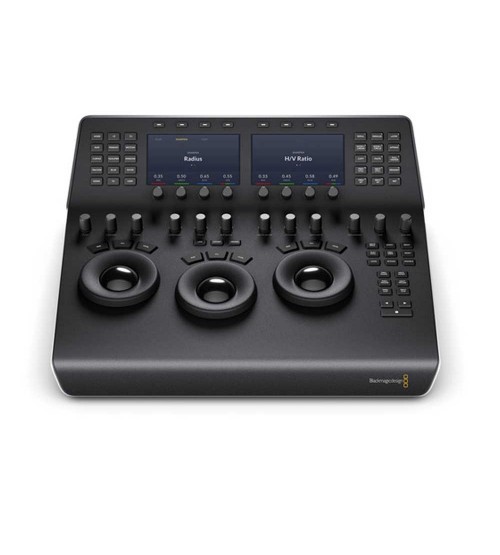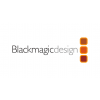Blackmagic Design DaVinci Resolve Mini Panel
PRODUCT HIGHLIGHTS
· 3 x High-Resolution Track Balls
·
12 Primary Correction-Control Knobs
·
18 Navigation and Transport Keys
·
Dedicated Feature Buttons
·
2 x LCD Information Display Screens
·
Backlit and Illuminated Buttons
·
USB Type-C and Ethernet Interface
·
Supports Mac and Windows
·
Supports Select Linux Installations
·
USB 3.0 Type-A to Type-C Cable Included
The DaVinci Resolve Mini Panel from Blackmagic Design is a step-up in functionality
from the Micro panel but without all the features of the Advanced panel. It is
a portable control surface suitable for those that need to switch between
editing and color grading. It can sit on your desk top, in a rack, or be bolted
to a surface. As with the Micro panel, it features three high-resolution,
weighted trackballs and 12 control knobs for accessing essential primary
color-correction tools in the Resolve software. 18 dedicated keys on the right
side also give you access to the most commonly used grading features and
playback controls.
However, the Mini Panel also features
two LCD screens that allow you to display menus or the parameters of the tools
you are working with. Eight customizable soft knobs provide precise control and
a quick reset by pushing the knob. Dedicated feature buttons allow you to
change tools without needing to use the mouse. The Mini panel incorporates a
USB Type-C and Ethernet interface. It is compatible with Mac, Windows, and
select Linux systems. You can power the panel via an AC power source, a 4-pin
XLR connector, or PoE. For the panel to work with Resolve, your computer must
be running DaVinci Resolve 12.5.5 or DaVinci Resolve Studio 12.5.5 or later. An
included USB 3.0 Type-A to USB Type-C cable provides backward compatibility for
systems that are limited to USB Type-A connectors.
·
Small enough to take with you, so you
can bring it to any Resolve system (12.5.5 or later) and do color correction on
location or at the editor's suite
·
Shares basic layout with both Micro and
Advanced Panels
·
Interfaces with and controls software
·
Three track balls with outer control
rings
·
Log and Offset color-correction
selection buttons
·
Buttons are backlit and light up when
actuated
·
Two LCD display screens for displaying
the menu system or the parameters of the tools you are wotking with
·
Custom control knobs with 4096 steps per
rotation and push button reset
Primary Correction Creative Control
Knobs
Control knobs are grouped into four sets
of three knobs
Luminance
·
Y Lift Control: Adjust the contrast of
the image in the darker areas, specifically in the Y (luminance) channel only.
This adjustment allows changing the black point without changing saturation.
·
Y Gamma Control: Adjust the contrast of
the image in the mid-tone areas, specifically in the Y (luminance) channel
only. This control helps add depth and extra vibrancy to shots
·
Y Gain: You can reduce hot spots or
tweak the whites to define a look.
Contrast
·
Contrast Control: Increase contrast to
make the blacks darker and the whites brighter, or decrease contrast to do the
opposite.
·
Pivot: Change the center of tonality
about which dark and bright parts of the image are stretched or narrowed during
a contrast adjustment.
·
Mid-Tone Detail: Affect the contrast of
regions of the image with high edge detail to increase or decrease the
perception of image sharpness and definition. Often used for softening facial
features making it popular for beauty shots.
Detail
·
Color Boost Control: Raise the
saturation in regions of the image with low saturation while leaving properly
saturated areas alone. Also known as a vibrance operation, this is useful for
adding color without over-saturating the image.
·
Shadow Control: Selectively lighten or
darken shadow detail without affecting your images mid-tones.
·
Highlight Control: Enable retrieving
blown-out highlight detail in high dynamic range media by lowering this
parameter. This allows you to achieve a smooth blend between the retrieved
highlights and unadjusted mid tones for a natural-looking image.
Saturation
Increases or decreases overall image
saturation — you can turn your color image into a grayscale image with this
control.
·
Hue Control: Rotates all hues of the
image around 360° of the color wheel. The default setting is 50, which retains
the original distribution of hues.
·
Luminance Mix Control: Controls the
balance between the YRGB adjustments and Y only adjustments made using the Y
channel lift, gamma, and gain controls.
The system powers from either AC power
or a 12 VDC source via the 4-pin XLR connector.
The Mini panel can sit on a desktop, be
mounted in a rack, or mounted to a surface to prevent theft or be used in a
moving vehicle or on a cart.
| Technical | |
| Warranty | Non Warranty |







